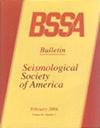Predictive Models for Seismic Source Parameters Based on Machine Learning and General Orthogonal Regression Approaches
IF 2.9
3区 地球科学
Q2 GEOCHEMISTRY & GEOPHYSICS
引用次数: 10
Abstract
Two sets of predictive models are developed based on the machine learning (ML) and general orthogonal regression (GOR) approaches for predicting the seismic source parameters including rupture width, rupture length, rupture area, and two slip parameters (i.e., the average and maximum slips of rupture surface). The predictive models are developed based on a compiled catalog consisting of 1190 sets of estimated source parameters. First, the Light Gradient Boosting Machine (LightGBM), which is a gradient boosting framework that uses tree-based learning algorithms, is utilized to develop the ML-based predictive models by employing five predictor variables consisting of moment magnitude (Mw), hypocenter depth, dip angle, fault-type, and subduction indicators. It is found that the developed ML-based models exhibit good performance in terms of predictive efficiency and generalization. Second, multiple source-scaling models are developed for predicting the source parameters based on the GOR approach, in which each functional form has one predictor variable only, that is, Mw. The performance of the GOR-based models is compared with existing source-scaling relationships. Both sets of the models developed are applicable in estimating the five source parameters in earthquake engineering-related applications.基于机器学习和一般正交回归方法的震源参数预测模型
基于机器学习(ML)和一般正交回归(GOR)方法,建立了两组预测模型,用于预测震源参数,包括破裂宽度、破裂长度、破裂面积和两个滑动参数(即破裂面平均和最大滑动)。预测模型是根据由1190组估计的源参数组成的汇编目录开发的。首先,采用基于树的学习算法的梯度增强框架Light Gradient Boosting Machine (LightGBM),利用矩量级(Mw)、震源深度、倾角、断层类型和俯冲指标等5个预测变量,建立基于ml的预测模型。结果表明,所建立的基于机器学习的模型在预测效率和泛化方面表现出良好的性能。其次,基于GOR方法建立了多个源尺度模型来预测源参数,其中每个函数形式只有一个预测变量,即Mw。将基于gore的模型的性能与现有的源缩放关系进行了比较。所建立的两套模型均适用于地震工程中五个震源参数的估计。
本文章由计算机程序翻译,如有差异,请以英文原文为准。
求助全文
约1分钟内获得全文
求助全文
来源期刊

Bulletin of the Seismological Society of America
地学-地球化学与地球物理
CiteScore
5.80
自引率
13.30%
发文量
140
审稿时长
3 months
期刊介绍:
The Bulletin of the Seismological Society of America, commonly referred to as BSSA, (ISSN 0037-1106) is the premier journal of advanced research in earthquake seismology and related disciplines. It first appeared in 1911 and became a bimonthly in 1963. Each issue is composed of scientific papers on the various aspects of seismology, including investigation of specific earthquakes, theoretical and observational studies of seismic waves, inverse methods for determining the structure of the Earth or the dynamics of the earthquake source, seismometry, earthquake hazard and risk estimation, seismotectonics, and earthquake engineering. Special issues focus on important earthquakes or rapidly changing topics in seismology. BSSA is published by the Seismological Society of America.
 求助内容:
求助内容: 应助结果提醒方式:
应助结果提醒方式:


